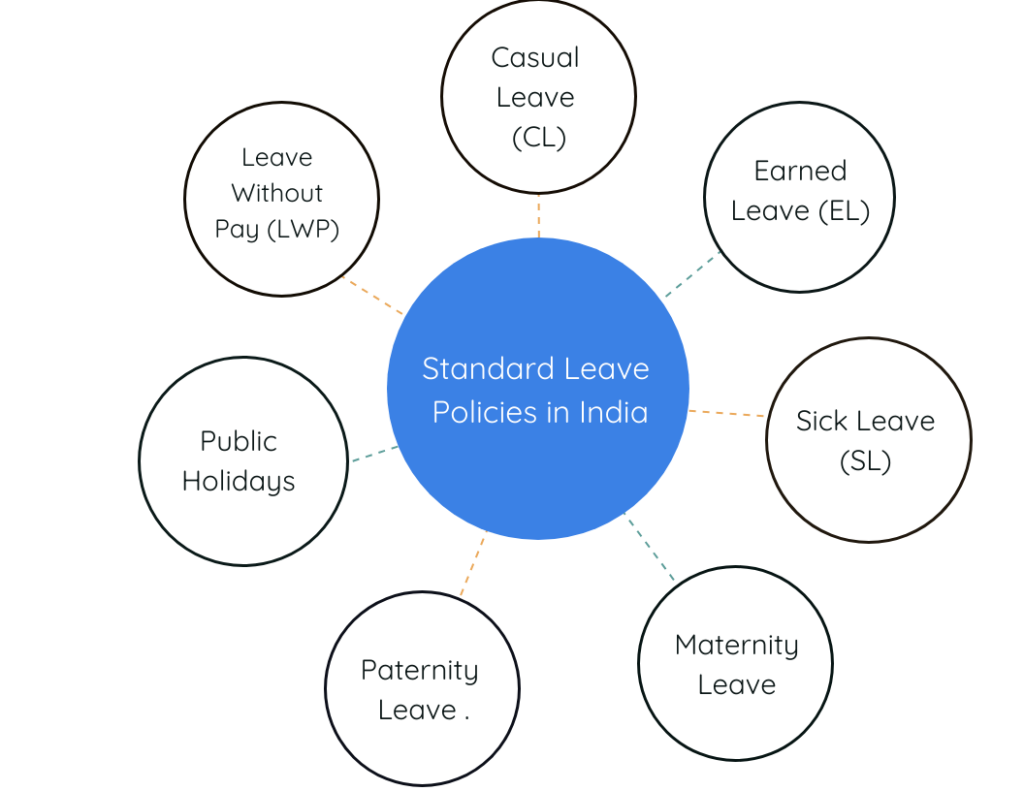Learn about the leave policy in India for private companies. Explore types of leave, legal compliance, state-wise rules, and best practices for startups and SMEs.
Table of Contents
- Introduction
- Legal Basis for Leave in India
- Types of Leave in Indian Private Companies
- State-wise Leave Requirements
- Designing a Competent Leave Policy
- Digital Leave Management with Asanify AI
- Common Challenges in Leave Policy Implementation
- Conclusion
- FAQs
Introduction
An effective leave policy is no mere HR formality; it is actually a critical component of employee satisfaction, productivity, and compliance with the law. For startups and SMEs, clear and transparent leave policies can have a tremendous impact on morale and even retention in India’s dynamic and competitive business environment. Hence, a clear and transparent leave-policy should be laid down.
No single national law exists in India controlling employee leaves across all private companies. However, the organization must comply with several legal frameworks, including state laws and some central acts defining minimum leave entitlements, especially on certain sectors and employee categories.
This blog will examine the leaves that every private company should know of, the laws regulating them, how policies vary across states, and the important practices that must be put in place to create an employee-friendly system of leave compliant with Indian labor laws.
Suggested Read: Types of Leaves in India – A Definitive Guide
Legal Basis for Leave in India
The leave entitlements from private companies in India cannot be covered only through either the state laws or the central laws, as combined applicability of both is needed. Fair and uniform leave benefits to employees are achieved through the operation of these regulations, while also ensuring that these employers are compliant. Below is a quick overview of the major legislations involved:
- Shops and Establishments Act (State Specific)
This act will probably be the most important regulation for any private company as it is not covered under the Factories Act. Every Indian state has its own version of the Shops and Establishments Act, which prescribes mandatory leave in that regard, such as:
- Annual/earned leave
- Casual leave
- Sick leave
- Holiday entitlements
For instance, the number of earned leave would be higher in Maharashtra than that in Karnataka; hence it becomes imperative for businesses to customize their leave policies as per specific state laws in which they operate.
2. Factories Act, 1948
Primarily applicable to manufacturing units, this central act prescribes certain minimum working conditions, inclusive of leaves. An employee working in a factory is entitled to:
- One day of earned leave for every 20 working days in a calendar year;
- Carry forward of earned leaves not utilized, subject to a limit.
- Maternity Benefit Act, 1961
It is the basic type of act that provides rights for women stepping into the workforce. Under this act, a female employee can enjoy:
- 26 weeks of paid maternity leave for the first two children;
- 12 weeks of paid leave for subsequent children but;
- Additional leave for miscarriage or medical conditions.
- New Labour Codes (Brief Mention)
The Indian government has enacted four new labour codes intended to simplify and unify multiple existing laws. Full implementation across India for these codes is still pending, and some expected standardization will take place in a few aspects like leave, wages, and working hours. The Code on Social Security and Occupational Safety, Health and Working Conditions.

Types of Leave in Indian Private Companies
a. Casual Leave (CL)
- Purpose: For short-term personal needs, emergencies, or unplanned obligations.
- Allowance: 7 to 12 days annually, depending on the company and state rules.
- Note: Usually requires prior notice unless in emergencies.
b. Sick Leave (SL)
- Purpose: For illness, medical recovery, or health-related issues.
- Allowance: 7 to 12 days per year as per state regulations.
- Note: May require a medical certificate for absences longer than 2–3 days.
c. Earned Leave (EL) / Privilege Leave (PL)
- Purpose: For planned vacations or personal time off.
- Allowance: 15 to 30 days annually, accrued monthly.
- Note: Often eligible for carry-forward and encashment.
d. Maternity Leave
- Purpose: For childbirth and postnatal recovery.
- Allowance: 26 weeks for the first two children, 12 weeks thereafter.
- Note: Mandated by the Maternity Benefit Act, 1961.
e. Paternity Leave (optional but increasingly offered)
- Purpose: To support fathers during childbirth and infant care.
- Allowance: 5 to 15 days (offered at employer’s discretion).
- Note: Not mandatory under Indian law, but increasingly common.
f. Compensatory Off (Comp-Off)
- Purpose: Time off in lieu of working on holidays or weekends.
- Allowance: Based on the actual number of extra days worked.
- Note: Usually must be used within 30 to 60 days of accrual
g. Leave Without Pay (LWP)
- Purpose: When other leave balances are exhausted.
- Allowance: No specific limit; subject to manager and HR approval.
- Note: May affect salary and benefits if taken excessively.
h. Special Leaves (e.g., bereavement, menstrual leave)
- Bereavement Leave – 2 to 5 days for death of immediate family.
- Menstrual Leave – 1 to 2 days per month (offered by some companies).
- Marriage Leave – 3 to 5 days (optional, based on internal policy).
- Adoption Leave – Duration varies, aligned with maternity/paternity norms.
Suggested Read: New Labour Laws: Effects on the working hours and annual leave of employees’
State-Wise Leave Requirements
Leave entitlements under the Shops and Establishments Act vary by state. Below is a comparison of minimum statutory requirements for key Indian states. These figures represent typical minimums for EL, Sl, and CL, but companies may offer more generous policies.
| State | EL Days | SL Days | CL Days | Notes |
| Maharashtra | 21 | 8 | – | Earned leaves accrues monthly |
| Delhi | 15 | 12 | 12 | Casual and sick leaves are separate |
| Karnataka | 18 | 12 | – | Typically combined as sick/casual |
| Tamil Nadu | 12 | 12 | – | 1 day earned leave for every 20 days worked |
| West Bengal | 14 | 14 | – | EL includes festival holidays in some cases |
| Telangana | 15 | 12 | – | Leave policy guided by Shops Act rules |
| Gujarat | 21 | 7 | – | EL accrual monthly; limited CL provisions |
Designing a Compliant Leave Policy
Define in internal offer letters and HR documents all types of leave (Casual, Sick, Earned, Maternity, Paternity, etc.).
- Mention the annual leave entitlement for each category.
- State the rules for leave accrual and its calculation either monthly or yearly, etc.
- Provide a clear guideline for carryforward of unused leaves.
- Mention the maximum number of days permissible for encashment of leave.
- Mention the rules for encashment of leave when resignation occurs or as per annual processing.
- Mention the notice duration applicable for each leave type (example: 7 days for Earned Leave, 1 day for Casual Leave).
- Define documents needed to apply for particular leave (example: medical certificate for Sick Leave).
- Define the procedure and format for leave request submissions.
- This should define the approval hierarchy for leave applications (example: team lead → HR → senior manager).
- An explicit policy should be made regarding unapproved leave cases or emergencies.
- The policy should conform in spirit to state-specific Shops and Establishment Act rules.
Digital Leave Management with Asanify AI
The manual method of managing leaves is bound to be plagued with confusion, mistakes, and compliance issues. That is where Asanify AI comes into the picture-an intelligent and powerful automation that fits the modern needs of an HR group or a founder. Following are the ways Asanify facilitates leave management:
- Employees and managers can view leave balances in real time.
- Slack and mobile-based approval for leave- no more chasing emails!
- Integrated with payroll for accurate salary deduction and leave encashments.
- Auto-generated audit-ready reports for labor law compliance across states.
- Policy enforcement-the way it should be done, without guesswork or manual calculations.
Asanify allows you to remain compliant while keeping your team satisfied and happy-a boon, especially for startups, and the best part, all that without lifting a finger!

Common Challenges in Leave Policy Implementation
Even when one wishes to do right in enforcing a leave policy, operational barriers might still come up when trying to neutralize, making such enforcement a challenge. Here are some of the usual challenges:
- Someone shared incorrect information about leave entitlements, which caused confusion and disputes.
- Mistakes stemming from manual tracking of leave, especially on Excel or spreadsheets
- Misuse of casual or sick leaves without fullproof documentation or suitable approvals
- Compliance issues in different states whereby the legislation differ
Thanks to systematic workflows, leave tracking in real time, and compliance in local areas, Asanify takes care of all the guesswork and manual errors so that the HR teams can find time to focus on strategic growth instead of paperwork.
Conclusion
A clear and adequately composed leave policy creates a balance of employee satisfaction, Indian labor law compliance, and a reduction in administrative hassles. It instills trust, minimizes disputes, and increases overall productivity of the workforce. Manual leave management becomes a boon and that too a very risky one as companies grow and scale, especially across different states.
“Want to automate leave tracking and stay compliant? Try Asanify AI for smart HR teams.”
FAQ Section (Questions Only)
- How many paid leaves are private companies required to give in India?
The paid leave granted by private companies generally ranges from 15 to 30 days and comprises Earned Leave, Sick Leave, and Casual Leave depending on state laws and company policies.
- Is maternity leave mandatory in private companies?
Yes, under the Maternity Benefit Act, female employees have the right to take paid maternity leave of 26 weeks for the first two children.
- Can earned leave be carried forward or encashed?
Yes, many organizations allow carry forward of earned leave somewhere between 30-45 days while some allow encashment either at the end of the year or at exit.
- What is the rule for sick leave in India?
Sick leave provisions vary by state but usually start at 7- 12 days in a year; a medical certificate becomes mandatory for leave beyond that.
- Is paternity leave compulsory under Indian law?
Although the law does not address it, most private companies provide 5-15 days as paternity leave in the ambit of progressive HR practices.
- How can companies comply with different state leave laws?
They can refer to the relevant Shops and Establishments Act of that particular state and adjust their leave policies accordingly, or use HR tech platforms like Asanify that automatically aligns for compliance.
- Are startups exempt from leave policy requirements?
No. All private establishments irrespective of their being start-ups must comply with basic labor law requirements as far as leave entitlements under relevant state acts are concerned.
- What happens to unused leave when an employee resigns?
The company typically encashes unused earned leave during final settlement, following its leave encashment policy and applicable labor laws.
- Can private companies offer unlimited leave?
Yes, although not common, some organizations provide unlimited leave as a flexible benefit. It must be clearly defined and tracked to avoid abuses.
- How does Asanify help manage leave policies?
Asanify automates leave tracking, approval workflows, and compliance across states, syncing with payroll and generating audit-ready reports instead to save time and effort.
Not to be considered as tax, legal, financial or HR advice. Regulations change over time so please consult a lawyer, accountant or Labour Law expert for specific guidance.



